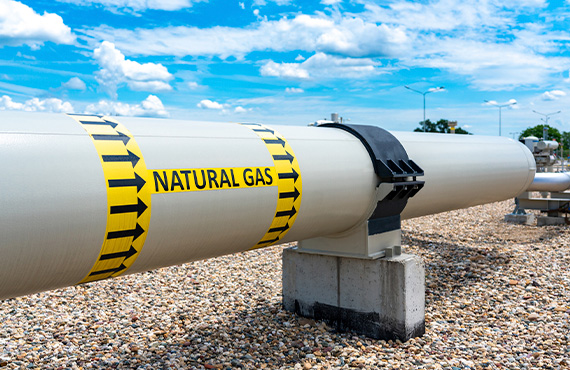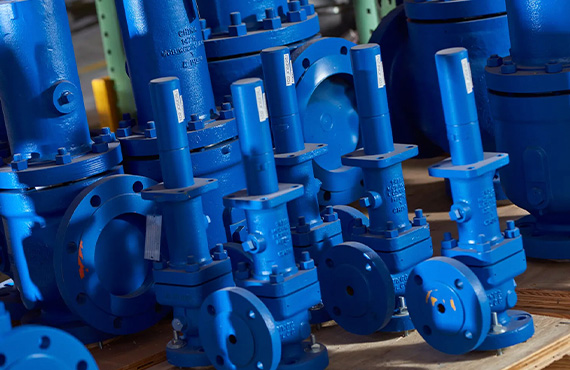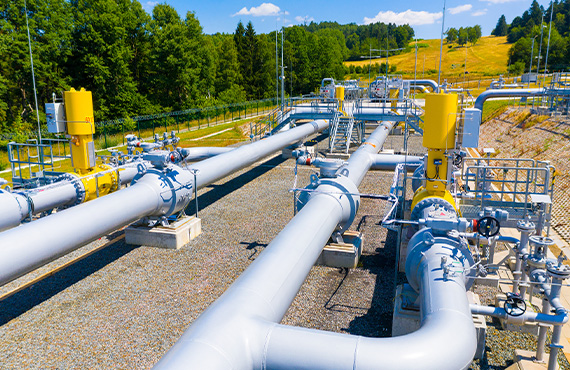
Ensuring safety in natural gas distribution is critical for protecting both infrastructure and public well-being. Overpressure protection in natural gas distribution systems plays a vital role in preventing excessive pressure that can lead to equipment failures and hazardous conditions.
Several overpressure protection methods, including Pressure Relief Valves (PRV), Slam-Shut Valves, and Series Regulators, offer robust solutions for maintaining safe pressure levels. This article aims to explore these methods in detail, highlighting their significance and guiding you through the essential strategies for enhancing safety within natural gas distribution networks.
Understanding Overpressure Protection in Natural Gas Systems
Ensuring safety in natural gas distribution starts with understanding the critical role of overpressure protection methods. In natural gas systems, overpressure protection serves as a safeguard against excessive pressure that can lead to hazardous conditions. The primary function is to regulate and maintain safe levels of natural gas pressure, protecting infrastructure and lives.
Overpressure Protection: A set of mechanisms designed to prevent the buildup of pressure beyond safe limits in natural gas systems.
Significance: Essential for mitigating risks like equipment failure, leaks, or explosions, thus ensuring continuous and safe operation.

Common Causes of Overpressure in Natural Gas Systems
Valve Regulator Failures: Malfunctions in regulators can lead to uncontrolled pressure increases.
Mechanical Issues: Wear and tear or defects in system components may cause pressure surges.
Blockages: Obstructions in natural gas pipelines can result in dangerous pressure accumulation.
What are Some Potential Consequences of Overpressure?
Equipment Damage: Uncontrolled pressure can cause pipelines and other components to fail.
Safety Hazards: High-pressure incidents might lead to fires or explosions, posing threats to public safety.
Service Disruptions: Overpressure events can interrupt gas supply, affecting residential and commercial users.
Understanding these elements underscores the necessity of robust natural gas overpressure protection devices. Each device plays a vital role in maintaining system integrity and preventing potential disasters.
Types of Overpressure Protection Devices Used in Natural Gas Distribution
1. Pressure Relief Valves (PRV)
Ensuring safety in natural gas distribution hinges on the effectiveness of overpressure protection devices, with PRVs playing a pivotal role. These devices are designed to automatically release excess pressure from the system, thereby averting potential hazards such as equipment failure or explosions.
Functionality and Operation of PRVs:
Automatic Activation: PRVs are engineered to sense when pressure levels exceed a pre-set threshold. Upon detection, they open to vent the surplus pressure, subsequently closing once normal conditions are restored.
Reliability: By offering a fail-safe mechanism that requires no manual intervention during operation, PRVs significantly enhance system reliability.
Different Types of PRVs and Their Applications:
Several types of PRVs cater to various needs within natural gas distribution systems. Selecting the appropriate type is crucial for achieving optimal safety and performance.
Direct-Operated Relief Valves:
- Ideal for smaller capacity systems where rapid response is essential.
- These valves directly respond to pressure changes without auxiliary power or additional sensors.
Pilot-Operated Relief Valves:
- Suitable for high-capacity systems requiring precise pressure control.
- Operate using a pilot valve that controls the main valve's opening and closing based on pressure readings.
Pop-Type Relief Valves:
- Commonly used in scenarios where sudden large volumes of natural gas need venting quickly.
- Known for their rapid "popping" action that ensures swift pressure relief.
Internal Relief Valves:
- Often integrated within regulators to provide a secondary line of defense against overpressure.
- Designed to relieve pressure by redirecting it internally rather than venting externally.
Utilizing these different types of PRVs strategically across your natural gas distribution network can help tailor overpressure protection to specific system requirements, ensuring robust safety mechanisms are always in place.
Emphasizing the importance of understanding each type's functionality helps you make informed decisions about which PRV best suits your system's needs, ultimately contributing to safer natural gas distribution practices. Now let’s dive into the next type, slam-shut valves.
2. Slam-Shut Valves
Slam-shut valves are critical components in ensuring safety during natural gas distribution, particularly when dealing with overpressure and under-pressure situations. These devices operate through an automatic closure mechanism that activates when detecting unusual pressure levels. Once triggered, the valve slams shut, halting natural gas flow until manually reset, thus providing a robust safeguard against excessive pressure.
Benefits of Slam-Shut Valves:
Dual Protection: These valves not only address overpressure concerns but also prevent under-pressure scenarios which could lead to dangerous natural gas accumulation.
Reliability: Their ability to react swiftly to pressure anomalies ensures that systems remain secure without requiring constant human intervention.
Selecting the appropriate device for specific applications is essential in maintaining optimal safety standards. While pressure relief valves and relief monitors play their roles, slam-shut valves offer a unique combination of immediacy and reliability that can be indispensable in certain environments. Now let’s dive into the next type, worker/monitor valves.
3. Worker/Monitor Valves
In high-pressure systems, worker/monitor valves play a crucial role in ensuring safe natural gas distribution, particularly in densely populated areas where safety is paramount.
Operation
These control valves utilize a pressure-sensing device to maintain appropriate pressure levels without venting natural gas into the atmosphere. This makes them ideal for urban environments where minimizing environmental impact is essential.
Maintenance Considerations
Regular maintenance is vital for optimal performance. Ensuring that these valves remain free from blockages and mechanical issues prevents potential failures that could disrupt service or compromise safety.
Selecting the right overpressure protection device, such as worker/monitor valves, is critical for specific applications. They complement other devices like pressure relief valves, slam shut valves, and relief monitors by providing a reliable solution tailored to unique operational needs.
The Role of Series Regulation as a Safety Measure in Natural Gas Distribution Systems
Series regulation method is crucial for ensuring safety in natural gas distribution systems by keeping downstream pressure levels safe. This technique uses a two-regulator system, where each regulator has a specific job to prevent overpressure situations.
How Series Regulation Works
Operation: The first regulator controls the inlet pressure, setting it at a level suitable for the second regulator. This second regulator then ensures that the natural gas pressure delivered to consumers remains within safe limits, protecting against both sudden spikes and drops.
Benefits of Series Regulation
Redundancy: Having two regulators in sequence provides an extra layer of protection. If one regulator fails, the other can still control the pressure, reducing the risk of dangerous overpressure situations.
Reliability: The series regulation method is reliable in maintaining consistent pressure levels even when supply conditions fluctuate. This reliability is critical for preventing equipment damage and ensuring uninterrupted service.
Mitigation of Regulator Failures: In cases where mechanical or operational failure could happen, series regulation acts as a backup mechanism. It ensures that any potential fault in one regulator doesn't compromise the overall safety of the natural gas distribution system.
Using series regulation makes natural gas distribution networks stronger and is an essential part of comprehensive overpressure protection strategies.

Regulatory Compliance: Ensuring Effective Overpressure Protection Measures are in Place for Safe Natural Gas Distribution
Ensuring safety in natural gas distribution systems requires strict adherence to regulatory standards. The Pipeline and Hazardous Materials Safety Administration (PHMSA) plays a crucial role in establishing these standards. PHMSA's advisories are essential in guiding the implementation of OPP measures. Their regulations focus on minimizing risks associated with low-pressure distribution systems and preventing overpressure incidents.
Key Roles of PHMSA:
Issuing Safety Standards: PHMSA sets comprehensive regulations that govern the design, installation, operation, and maintenance of natural gas distribution systems.
Monitoring Compliance: Regular inspections and audits ensure operators adhere to mandated safety protocols.
Providing Guidance: Through advisories and bulletins, PHMSA educates operators about evolving safety practices and technological advancements.
Adhering to these regulations is not just a legal obligation but a commitment to public safety. Non-compliance can lead to severe consequences, including:
Fines and Penalties: Operators face financial penalties for failing to meet safety standards.
Increased Risk of Incidents: Without proper OPP measures, the likelihood of accidents, equipment failure, and hazardous conditions increases significantly.
Implementing effective OPP strategies in line with regulatory requirements ensures safer natural gas distribution operations, protecting both infrastructure and communities.
Future Trends: Advanced Technologies Shaping the Future of Overpressure Protection Solutions in Gas Distribution Systems
The world of natural gas distribution is changing quickly, with digitization playing a crucial role in improving safety measures. By using digital technologies, operators can now use predictive maintenance to anticipate potential system failures before they happen. This proactive approach reduces the risks associated with overpressure events and ensures smooth operations.
Emerging technologies are also taking center stage in revolutionizing overpressure protection capabilities:
Automated Pressure Control Systems: These systems use real-time data analysis to automatically adjust pressure levels, ensuring optimal performance and safety. By using sensors and smart algorithms, these systems can identify problems and make quick adjustments without human involvement.
Internet of Things (IoT) Integration: IoT devices provide unprecedented connectivity between different parts of the natural gas distribution network. This integration allows for continuous monitoring and immediate communication throughout the system, enabling faster response times to address any overpressure threats.
Advanced Sensor Technologies: Sensors have become more advanced, capable of detecting even the smallest changes in pressure. This accuracy helps maintain stable operating conditions and prevents potential overpressure situations.
Machine Learning and AI: Using industrial AI-driven models can forecast pressure patterns based on past data, helping operators make informed decisions about system adjustments needed to maintain safe pressure levels.
These innovations not only improve safety but also make operations more efficient, reduce manual interventions, and lower operational costs—creating a stronger natural gas distribution network. As these technologies continue to develop, they have the potential to establish new standards in overpressure protection.
The Ongoing Effort to Ensure Safety in Natural Gas Distribution with Strong Overpressure Protection Measures
Safety in natural gas distribution is extremely important. Overpressure protection (OPP) is crucial in preventing potential dangers like equipment failure and explosions. Achieving safety is an ongoing process that requires constant improvement in OPP practices.
Continuous Improvement
Regular updates and enhancements to overpressure protection systems are necessary to adapt to evolving challenges and technologies. This involves:
- Monitoring emerging trends.
- Implementing advanced technologies.
- Reviewing regulatory requirements consistently.
For those seeking reliable solutions, exploring options with Proconex will provide access to innovative overpressure protection devices and systems that can enhance the safety and reliability of your natural gas distribution networks. By staying committed to strong overpressure protection measures, we not only meet legal requirements but also ensure the safety of communities and infrastructure.
